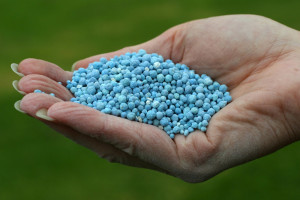When you use lawn fertilizers properly, it makes the difference.
Lawn Fertilizer
You must apply the right lawn fertilizer in the right way. This will make a crucial difference between your beautiful landscape flourishing every year or merely crippling along.
Nutrients
Chemicals like nitrogen, phosphorus and potassium are used to make lawn fertilizers. Nitrogen promotes cell division among plants and lush growth. Phosphorus helps with photosynthesis and fruit production. Potassium helps plants absorb the other two primary macro-nutrients.
Micro-nutrients are also found in lawn fertilizer. These, along with secondary macro-nutrients help with healthy growth. However, the brand of lawn fertilizer can determine how much of which nutrients are found. Soil testing determines how much micro and macro-nutrients to add to soil to make it fertile.
Testing
Soil can have different nutrient levels in different areas. Soil tests determine how much nutrients are needed for each area. Too much fertilizer will cause fertilizer burn. On the other hand, less than desired results are caused by not enough fertilizer. According to the University of Hawaii’s website, you should test soil samples every one to five acres in each test area. University-based or private labs test soil nutrient levels for a small fee. Lawn and garden stores also sell soil-testing kits.
Application
The type of fertilizer and the type of grass determines fertilizer application . The University of Illinois suggests applying fertilizer in early May, early September and late fall. However, depending on the type of fertilizer used, the application may be more or less frequent. For instance, the powder variety of fertilizer needs more application during the season than the pelleted fertilizer. This is because it absorbs into soil quicker. Moisture is needed to help soil absorb the nutrients. Therefore, it is best to apply any type of fertilizer directly after a period of heavy rain or before a period of light rain.
Rain Warnings
When you apply fertilizer directly before heavy rain spells it will not absorb into the soil. This is because the heavy rain causes a washout of the fertilizer. Washouts, in turn serve to remove it from the lawn and into runoff locations. According to the University of Minnesota, phosphorus, a macro-nutrient in fertilizer, causes the growth of algae and weeds in lakes. The growth of weeds and algae in lakes because of fertilizer runoff is a common ecological problem. However, light to moderate rain will not cause a washout. It will actually help the fertilizer absorb into the soil.
Liquid Fertilizer
Application methods for liquid fertilizer are different from the application for granular, powder and pelleted varieties. First of all, to be most effective, liquid fertilizer is best applied directly after periods of steady rain. This makes it easier for the soil to absorb the nutrients. Liquid fertilizer absorbs immediately into soil within one to two days after applications. While you must apply the other varieties when dissolved before nutrients are absorbed.
For more… stay tuned into the monthly blog that has great information to all your landscaping needs….
